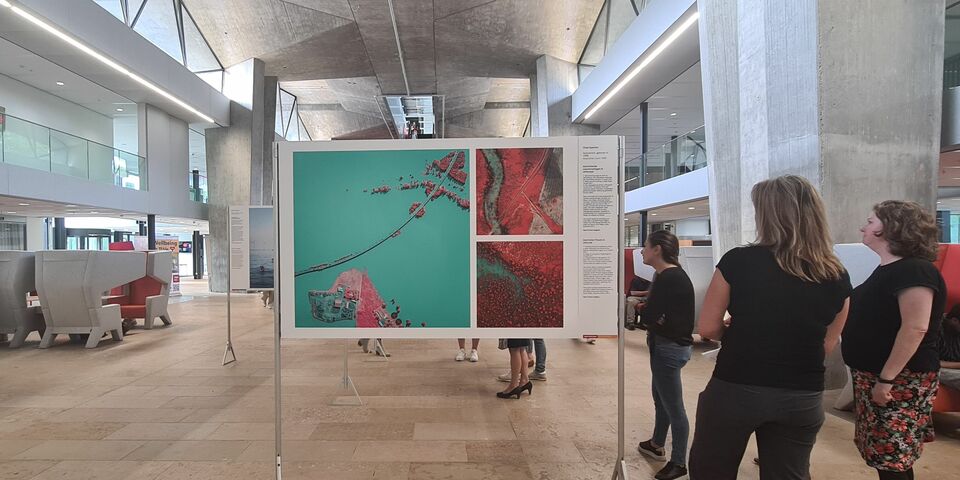World Press Photo: beautiful images, ugly facts
TU/e is one of seventy locations worldwide where the World Press Photo Exhibition is held. If you want to check out this exhibition, organized by Studium Generale, you’d better hurry to the entrance hall of the Atlas building: the prizewinning journalism photos will be on show until and including this Tuesday. The images are harrowing, sometimes even heartbreaking, but sometimes a glimmer of hope shines through.
Founded in 1955, World Press Photo is a Dutch non-profit organization that aims to promote photojournalism. One of the things it does to this end is award annual prizes to the best news photographs worldwide. Those photos are turned into an international exhibition hosted by a total of seventy locations each year, including TU/E – specifically Studium Generale.
The exhibition in the entrance hall of the Atlas building on campus can be visited for free until and including this Tuesday (26 September). The photos have informative captions, with a QR code linking to an audio guide in several languages. What’s more, World Press Photo provides more background on all exhibited photos on its website.
Cursor went on one of the student-guided tours of the exhibition. Our guide was Ariadna – Ari for short – Masot Llima. The Spanish national studies Biomedical Engineering and acting as a tour guide is one of the final activities she’s undertaking in the context of her 2022-2023 board membership of photography association Dekate Mousa.
“I myself have a preference for travel and portrait photography, but at Dekate Mousa I discovered that almost all photo genres appeal to me.” What moves her in the exhibited photographs is how they make news fact relatable by giving them a face.
Very close
Up to two years ago, World Press Photo classified submissions into different thematic categories, such as news and sport. These days, in the interest of representativeness, this categorization has been replaced by a division into regions: Africa, Asia, Europe, North and Central America, South America, and Southeast Asia and Oceania.
To prevent a western-skewed perspective, each region selects its own winners and honorable mentions. As a result, the exhibition showcases international issues that hardly get any media attention over here. But for the people in the photographs, the recorded facts are a life-determining reality.
Nick Hannes, for instance, captured how regimes in various African countries are rapidly building new capital cities (New Capital) at more advantageous locations than the original capitals. It concerns cities that are being built by immigrants, under the most terrible of working conditions. “Modern slavery,” says Ari. To make matters worse, the vast majority of the population cannot afford the brand-new residences, which widens the gap between the government and the citizens in countries where democracy is often already under pressure.
Also very poignant are Weimin Shu’s pictures of Chinese people who invested in real estate but lost their money in the construction industry crisis (Faint Light in the Unfinished Building). After the building company went bankrupt, they were forced to sell their own home and move into their investment project – an apartment that wasn’t finished and will never be finished – where they live in very poor conditions.
Mariupol
World Press Photo is an exhibition that your Cursor editor looks forward to and dreads in equal measure, having experienced how much of an impact the pictures, in spite of their aesthetic beauty, will make. The human suffering, displayed in all its rawness, is often quite tremendous.
A sad case in point is this edition’s global winner: Mariupol Maternity Hospital Airstrike. The ‘photo of the year’, taken in the Ukranian city of Mariupol, is the famous depiction of a heavily pregnant woman being carried on a stretcher from the remains of a bombed hospital.
Ari tells us that the mother, Iryna Kalinina, gave birth to a stillborn baby shortly after the picture was taken, passing away herself half an hour later. Everyone’s quiet. “Heartbreaking,” Ari says, expressing how we feel. She continues by telling us about the importance of the report from Mariupol by photographer Evgeniy Maloletka. Not only to create worldwide awareness, but also because the images served as proof refuting the Russian attacker’s claim of not having targeted public places.
Alpacas
Ari says that World Press Photo is aware that glimmers of hope like this one, suggesting not everything was in vain, are important for the audience. The organization therefore makes a conscious effort to showcase images of optimism and hope, of people all over the world looking for solutions for the major problems of our time, such as climate change.
This is why we conclude our visit with photos of sustainable energy projects involving geothermic energy and algae in Iceland (Net-Zero Transition), and of a project in the Andes (Alpaqueros) where alpaca breeds are created for better resistance to the increasingly extreme weather conditions.




Discussion